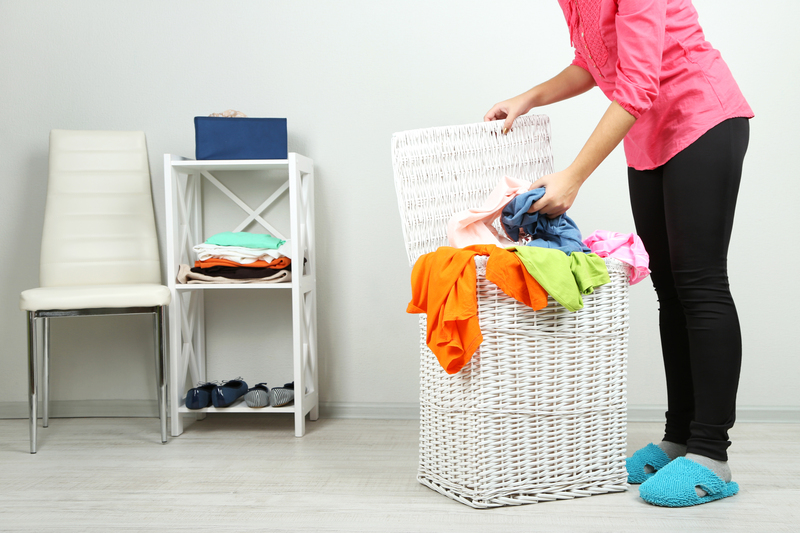Leather Sofa Care: Should You Consider Steam Cleaning?
Posted on 31/08/2025
Leather Sofa Care: Should You Consider Steam Cleaning?
Leather sofas add a touch of sophistication and luxury to any living space. Their smooth finish, elegant appearance, and undeniable comfort make them a popular choice for homeowners. However, with great beauty comes great responsibility. Proper maintenance is crucial to prolong the life of your leather furniture. Among the many cleaning methods available, steam cleaning has become a trending topic. But, should you steam clean your leather sofa, or is it a risky venture?
Understanding Leather: Material Characteristics and Care Requirements
Leather is a natural, porous material, crafted from animal hides and tanned using various processes. There are several types of leather commonly used in sofas:
- Aniline leather: Known for its soft, luxurious feel and natural surface. Lacks a protective coating, making it susceptible to stains.
- Protected or semi-aniline leather: Has a light protective layer, making it more resistant to stains and spills.
- Bicast leather: Split leather with a synthetic coating, often shiny and affordable, but less breathable.
- Bonded leather: Contains only a small percentage of genuine leather, with polymers and adhesives making up the rest.
Keeping these distinctions in mind is essential when choosing any cleaning method, including steam cleaning.

Common Leather Sofa Cleaning Methods
Proper cleaning and maintenance are vital to keep your leather sofa looking pristine. Here are the most popular approaches:
- Dry dusting: Using a microfiber cloth removes dust and prevents grime buildup.
- Vacuuming: Attaching a brush tool vacuums crumbs and debris from crevices without scratching.
- Wiping with damp cloth: Slightly dampened cloths can remove light dirt, but excessive water should be avoided.
- Specialized leather cleaner: pH-balanced cleaners designed for leather provide deep cleaning without damage.
- Conditioning: Leather conditioners help maintain suppleness, prevent drying, and resist cracking.
- Professional cleaning: For intensive stains or delicate leathers, hiring leather cleaning specialists is advised.
But where does steam cleaning fit in?
What Is Steam Cleaning?
Steam cleaning uses high-temperature steam to break down dirt, kill bacteria, and remove grime. It's a common method for cleaning carpets, upholstery, and tiles, as it sanitizes surfaces without harsh chemicals.
- Steam cleaning is eco-friendly, using only water
- It penetrates deep into fabric fibers for a thorough clean
- Reduces allergens, bacteria, and lingering odors
However, the suitability of steam cleaning for leather sofas remains a debatable subject.
Can You Steam Clean Leather Sofas?
Potential Benefits of Steam Cleaning Leather Sofas
- Sanitization: High temperatures kill bacteria and dust mites on and beneath the leather's surface.
- Stain removal: Steam can loosen stubborn dirt, making it easier to wipe away.
- Odor neutralization: Heat and moisture can help eliminate unwanted smells.
Risks and Drawbacks of Steam Cleaning Leather Furniture
- Moisture damage: Too much water can seep beneath the coating, causing warping, stiffness, or mildew growth.
- Loss of natural oils: Steam may strip away essential oils, leading to dryness, fading, or cracks.
- Finish degradation: High heat can damage certain finishes, especially on delicate types like aniline leather.
- Warranty issues: Many sofa manufacturers void warranties if steam cleaning causes damage.
Verdict: While steam cleaning can be effective in certain situations, it is generally not recommended as a routine method for leather sofas due to the potential risks involved.
Expert Guidance: When (If Ever) Should You Steam Clean Leather Sofas?
If you are still considering steam cleaning your leather sofa, here are some important guidelines:
- Check the manufacture's care label: Always consult the sofa's cleaning instructions. If steam cleaning is not endorsed, avoid it.
- Test a hidden area: Apply steam to an inconspicuous section to check for adverse reactions before proceeding.
- Use low heat and minimal moisture: Set your steamer on the lowest setting. Never saturate the leather.
- Keep the steam nozzle moving: Keep the nozzle several inches away and keep it moving to avoid direct heat on one spot.
- Immediately dry and condition: Wipe excess moisture off and apply leather conditioner once finished to restore lost oils.
If in doubt, consult a professional leather cleaning service. They have the expertise and specialized equipment to ensure your sofa is cleaned safely.
Alternatives to Steam Cleaning for Leather Sofas
For most homeowners, safer, effective leather sofa cleaning methods include:
- Damp Cloth Wiping: Use a slightly damp microfiber cloth followed by a dry one to gently remove surface dirt.
- Leather Cleaners: Apply commercial or homemade leather cleaners with a soft sponge. Avoid products containing alcohol, ammonia, or harsh solvents.
- Routine Conditioning: Every six months, conditions your sofa with a quality leather conditioner to maintain softness and moisture.
- Immediate Stain Response: Blot fresh spills with a clean, dry cloth and avoid scrubbing, which could worsen stains or damage the finish.
- Professional Cleaning: Particularly for expensive or antique leather sofas, hire specialized cleaning experts at least once a year.
Tips for Long-Term Leather Sofa Care
- Avoid direct sunlight: Prolonged exposure to sunlight can lead to fading and cracking.
- Keep away from heat sources: Don't place your sofa near radiators or heating vents, which can dry out the leather.
- Maintain a stable humidity level: Extremely dry or humid environments can adversely affect leather.
- Rotate and fluff cushions: Evenly distribute wear to extend your sofa's life.
- Pet protection: Use throws to minimize pet-related scratches or stains.
Ongoing maintenance is the best way to avoid deep cleaning needs and preserve your sofa's investment value.
DIY Leather Sofa Cleaning: Safe Techniques
Routine Cleaning Steps:
- Dust the surface with a soft microfiber cloth weekly.
- Vacuum crevices gently using a brush attachment.
- Prepare a mild cleaning solution - mix a few drops of gentle dish soap with distilled water.
- Dampen a cloth in the solution (never soaking wet!), wring thoroughly, then wipe the sofa surface.
- Rinse the cloth in clean water, wipe again to remove any soap residue.
- Immediately dry with an absorbent, clean towel.
- Apply a leather conditioner evenly, following the product instructions.
Spot Cleaning Tough Stains:
- For greasy stains, sprinkle a bit of talcum powder, let sit for a few hours, and brush off gently.
- For ink marks, use a cotton swab dipped in rubbing alcohol and gently dab (test first!).
- Always finish with a conditioner to rehydrate the area.
Leather Sofa Cleaning: What to Avoid
Regardless of your approach, always avoid the following mistakes:
- Using harsh chemicals: Products containing alcohol, bleach, or ammonia can strip color and finish.
- Over-wetting: Excess water can lead to stains, warping, or mildew inside cushions.
- Ignoring manufacturer's care guidelines: Every leather is different and may react uniquely to cleaning methods.
- Scrubbing vigorously: Can damage finish, removing dyes or causing surface roughness.
Steam Cleaning Versus Professional Leather Sofa Cleaners
Professional leather cleaning services differ from general steam cleaners in a few significant ways:
- They use pH-balanced solutions and moisture-controlled techniques for safe, deep cleaning.
- Technicians are trained to identify leather types and select the best approach accordingly.
- Proper aftercare, such as reconditioning, is always included--this is essential after any intensive cleaning.
- Many professionals offer stain protection treatments post-cleaning, further extending your sofa's life.
If your leather sofa is a valuable investment, or if you're dealing with deep stains or odors, professional care is the way to go.

Frequently Asked Questions About Leather Sofa Cleaning
Can I steam clean every type of leather sofa?
No. Some leathers (especially aniline and nubuck) are highly sensitive to heat and moisture. Using a steam cleaner can destroy their finish. Always check the label or consult your sofa's manufacturer first.
What about faux or bicast leather? Is steam cleaning safe?
Bicast and faux leathers may tolerate steam cleaning better than untreated natural leathers, but risks remain, including disintegration of adhesive layers or surface cracks. Always test in an inconspicuous area first.
What if my leather feels sticky after steam cleaning?
This is usually a sign that excessive moisture has seeped in or cleaning residues are left behind. Dry the area thoroughly and wipe again with a clean, damp cloth. Apply conditioner to restore suppleness.
How often should I deep-clean my leather sofa?
Deep cleaning, whether by professionals or DIY methods, is typically only needed once or twice a year. Regularly dust and condition more often to keep buildup at bay and preserve your sofa's beauty.
Conclusion: Is Steam Cleaning Worth It for Leather Sofas?
Leather sofa care is all about balance--clean often enough to avoid buildup but gently enough to preserve the material's integrity. Steam cleaning is an appealing solution for sanitization and stain removal, but it is not the safest or most recommended routine method for leather furniture. The risk of moisture and heat damage far outweighs the potential benefits for most sofas.
For the best results, stick to mild, pH-balanced cleaning agents, gentle wiping, and regular conditioning. If extra attention is needed, especially with valuable or delicate pieces, entrust your leather sofa to a professional cleaning service to ensure safety and longevity.
Taking the right approach to leather sofa cleaning will reward you with years of comfort, elegance, and lasting beauty in your living space.



